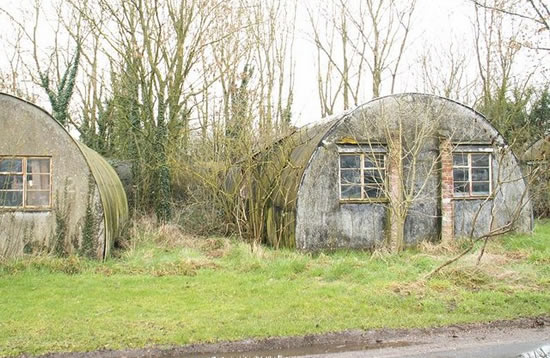The GIs in Newport
By Michele Lewis B.A. pg Dip Lib
Introduction
When I first began to research this article I realised that information about the GIs in Newport in WW2 was not going to be as easy to get hold of as I had first thought. I had, perhaps, left it too late. After all, the information was over 60 years old and anyone left with any clear memories of the time would be therefore elderly, probably well into their eighties and nineties.
A letter to the “South Wales Argus” asking for help from its readers was my first and most obvious step. It produced a good result very quickly, and from the recollections in the correspondence I was able to move on and gain further leads.
Many of the people who wrote to me and to whom I later spoke on the telephone were only too pleased to share their memories and one or two even asked me for help in pursuing their own lines of enquiry. I was off quickly to a good start.
My reasons for writing the article are not quite so straightforward. From an early age I had been brought up on a diet of stories about the war. My maternal grandfather was a great story teller and he had a lovely voice which left me entranced. We used to sit at the table after meals and my grancha would regale us with the stories of his family and Newport Docks and usually the stories would end up with one or two about the Americans. All my aunts had tales to tell and some would be told over and over again. I loved hearing them all. I only wish that I had recorded them at the time.
As the years have gone by, and we now all have our own families and grancha has died and so many of the family have passed on, we no longer get the chance to reminisce about the war years, the stories have been forgotten. So my purpose in writing this article is to gather together facts and some of the family stories and add them to the memories of those who lived through the period when the Americans “occupied” Newport.
Acknowledgements
There are so many people I must thank for their help in writing this article. Most of them are the ordinary people of Newport, who spent time and effort in writing to me to give me a picture of Newport in those years between 1942 and 1946 when the last group of GIs left Newport.
I must first thank the Letters Page of the “South Wales Argus” for accepting my letter and enabling so many people to contact me by post and telephone.
The staff of Newport Central Library were a great help and although they did not have much information they were able to point me in the right direction and gave me so much help with those infernal microfiche readers which cause me so much trouble and frustration.
I also made enquiries at the Public Record Office in Cwmbran. Surprisingly they had little information but again they were able to supply me with addresses and possible avenues to follow and thankfully they have kept my enquiry ‘alive’ and have sent me updates occasionally.
Most of the help I received came from the ordinary Newport Public who were willing to put their stories in writing and tell me so much more; when later I was able to speak to them on the telephone. I even located lost family friends and the whole thing was very enjoyable.
I received letters from Mr. T. Charles, Mrs. B. Abako, and Mrs. Gloria Hadden, Mr. Jim Dyer, Mrs. J Scannel and very specially Mr. Haydn Davies the well known and much respected writer of Newport History.
When I began the research my first stop was the internet and I contacted Mr. David Woolven who, as always, was a mine of information about Newport. Like some of my correspondents he had some wonderful stories to tell especially about his schooldays at Stow Hill School. He was able to put me in touch with Mr. Des Carter who willingly allowed me to see a copy of his own “Wartime Memoirs” which were so useful because they are so personal. I learnt such a lot about my home town by reading his interesting information. Dave also put me in touch with Mr. David Hall who is another Local Historian from Newport. He was able to add considerably to my knowledge of the 756th R.S.B. (Railway Shop Battalion)
A friend of mine of many years standing Mr. Shaun McGuire was an enormous help and supplied many of the details about Newport in the war years. I had already used his site covering Newport’s War Dead extensively when I was researching my family genealogy (another ongoing project) http://www.newportsdead.shaunmcguire.co.uk/ I had many online chats with Shaun and he told me stories of the GIs at Tredegar Park.
My research began with one single piece of information which had been supplied by the Central Library. This was an emailed list of the troop postings in Newport from 1943-44. The library had obtained this a few years before. I contacted the email address which was amazingly still live. The man concerned who signed himself Phil told me that he had no further interest in the troops in Newport he just wanted to find out when and where they were stationed.
Finally I am indebted to an article in the” South Wales Argus” of 29th July 2009 written by Mr. Mike Buckinham “Reflecting on a Century of Memories”. This was written about Mrs. Florence Price on the occasion of her 100th birthday.
My thanks go also to the Newport Past web site for help and advice on many areas of my research.
To all these kind and interesting people I extend my fervent thanks and apologies to any that I have unintentionally omitted.
Contents
-
Background
-
Home from Home
-
The GIs came to Newport-Why Newport?
-
The ‘Friendly Invasion’
-
Recreation
-
Settling in to life in Newport
-
Wedding Belles
-
Behaviour and Attitudes
-
D-Day
-
We’re going Home!
-
Memories
-
South Wales Argus Cuttings
1 Background
During WW2 mainland Britain was one of the few countries in Europe to escape invasion by Hitler’s troops. An invasion had been planned, as Operation Sea Lion in 1940, but Hitler turned his troops away from British shores and attacked Soviet Russia instead. One country however, did accomplish a successful invasion… the U.S.A.
George Orwell was to call it an “occupation” as it truly came to be. At its height the American presence here in this tiny island numbered over 3.5 million; 15,000 of whom were stationed in the Monmouthshire area alone.
This, however, was a friendly invasion and it began officially in 1942. Previously many American nationals had come to Britain privately, to join the Air Force. Later these groups were granted the names of the Eagle Squadrons. They became operational in February 1941. It became a mark of pride and prestige to become part of one of these groups.
Many of the GIs travelling across the Atlantic on the troop ships had no inkling of their final destination. [1] They assumed, because they hadn’t been issued with any tropical kit, that they were going to Europe, and for most, this was the sum total of their information. A large proportion of them had no idea why they were fighting a war in Europe. They neither knew nor understood why America should get drawn into another European War. What possible advantages could there be for Americans in fighting Hitler?
For many years since World War One relations between Britain and the U.S.A. had been poor. The Majority of American politicians were anti war and as late as October 30th 1940 President Roosevelt was assuring American parents that “Your boys are not going to be sent to any foreign war”. [2] This attitude would have persisted surely, had not the devastating events of Pearl Harbour occurred on December 7th 1940. America was forced to accept that Japan and her Axis Allies could attack the mighty U.S.A. on her own shores.
Thus young inexperienced soldiers were thrust into a climate of mutual distrust. They were going to a country whose position they were unsure of, to a people who lived in a different world, who spoke a strange form of “American” in a plumy accent, who existed in a world of class distinction and who quite frankly didn’t want them there. Eventually the GIs discovered that the tiny little island was England (Britain) but they still had no idea where Wales was let alone Newport!
At first the British man in the street was unaware that they were here. It was not common knowledge that the earliest units of American troops who landed in Britain, were from, what came to be known as the 8th Air Wing. These units arrived at first in just two places, Liverpool and Newport Monmouthshire. Therefore the first American troop units to arrive were combat ready… the GIs were not. Until June 1944 the only Americans in Britain doing any fighting were airmen.
The GIs in Newport were almost all service and ancillary regiments, including the famous 756th RSB (Railway Shop Battalion). It was not until the immediate weeks and days preceding D-Day that combat troops thronged Newport Docks and packed Forge Lane in transport carriers waiting to board ships to take them to the beaches of Normandy
The 756th were vital to the war effort and most Newportonians would be amazed to hear that in little more than a period of two years over 700 engines were imported into Newport from the U.S.A. They were then re-assembled, re-steamed and then sent out all over Britain and France to replace engines and rolling stock damaged and destroyed in the bombing. At least 56 of these engines were diesel, until then almost unknown in Britain. [3]
2 Home from Home
The American service men based in Newport consisted of Quartermaster troops, signals, communication and postal units; truck drivers, clerical officers, nurses and most important of all pay and salary officers. There were detachments concerned with troop embarkation and for a while a head quarters unit was based in Newport.
On arrival they were introduced to their new homes. Some of the lucky ones were based in Malpas Court Camp. There is evidence that this was at one time the home of the 20th Postal Reg. Section 431212-431221.
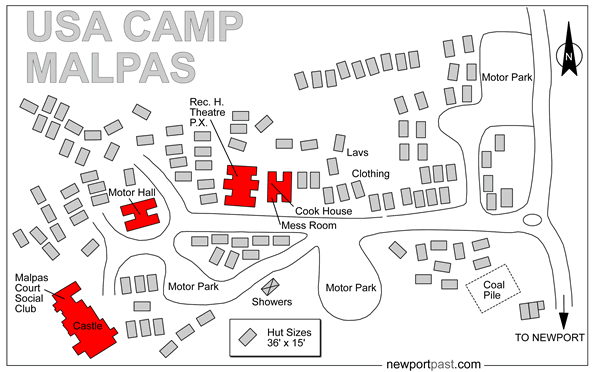
Plan of the USA Camp at Malpas Court.
The junior officers were billeted in the manor house itself. This had once been the home of Thomas Prothero, the one time Town Clerk and an influential citizen. The senior officers were housed in The Tredegar Arms Hotel and other ranks were housed in Nissen huts on the manor grounds. These housed between 20-30 men and consisted of a series of corrugated iron plates, buckled together to form a half cylinder based on a concrete floor. At each end was a brick wall and in the centre was a coke burning stove. There was usually a separate building housing toilet facilities known as “Ablutions”.
Some of the unlucky ones were housed in bell tents which were extremely uncomfortable no matter what the weather conditions. One such camp was on Farmer Thomas’s Fields which was near Cae-Perllan Road Newport. The Rangers were at Llanmartin on the outskirts of Newport. [4]

Plan of Llanmartin Camp
Kindly sent to us by Glenn Booker who writes the online GI Magazine
We hope to be able to display a more detailed image sometime in the future.
Des Carter and Dave Woolven remember the famous group commanded by Major William Frederick Greenhut, who were based at St Woolos School. They shared the building with the pupils and the Americans had the top floor so the school had to operate a shift system. Mrs. Gloria R. Cook neè McHugh says in her memoirs “The Americans came to school during the war so we had school afternoons one week mornings the next”. On 26th July 1946 St Woolos School log book records “Today school moves from Stow Hill central school premises, opposite the baths to our own premises at St Woolos School which have been occupied during the war years by the military, mostly by American armed Forces” .
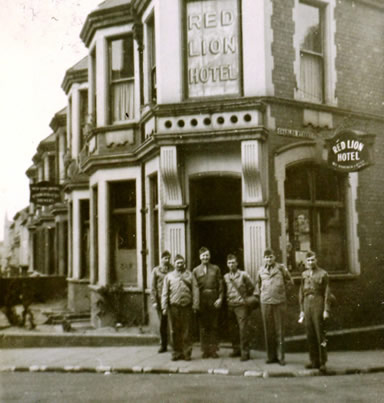
GIs outside the Red Lion on Stow Hill at the top of Charles Street. Newport during World War II.
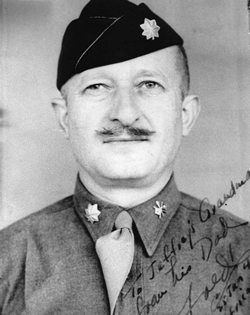
Major William Frederick Greenhut commander of the group based at St Woolos School.
When they left the school the troops left behind a sum of money to be used to provide an annual award for pupils.
There were two camps at St. Brides one for enlisted men and another for a corps of nurses who were, of course, officers. The 36th Ordinance Bomb Disposal Squad 43122-440126 were based at Tredegar Park. A troop of Afro-American soldiers were based at the Lighthouse Road and at St. Mellons near Cuckoo Bridge not far from the anti-aircraft guns were the AAF-516 group. [5]
Another group were based somewhere in Malpas. The very lucky ones or unlucky ones depending on their perspective, were billeted in private homes which was compulsory.
Two GIs, Wayne and John Uttrata, were originally based in the tented camp near Cae Perllan road but they became very friendly with Mrs. Florence Price who recollects “In those days we kept a more or less open house.” [6]
Eventually they spent most of their free time at her house and they became life-long friends of the family.
My own grandmother, Emily Dacey, also used to keep open house and many times it must have felt as if she was feeding the five thousand. Many of the members of her own family were either in the forces or working in the munitions factories and they often brought their friends home for her to entertain and to feed. My grandmother had six daughters, three of whom were single at the outbreak of war. Two worked in Lovell’s Sweet Factory and the other in Braithwaites (now Rowcord) by the Transporter Bridge. The girls met the GIs at local dances and soon they were bringing home these film star-like men with their beautifully cut uniforms and lazy southern drawl to be vetted by a very strict father.
Bryan Morse in his book “A Moment in History” states “The bulk of the American Divisions in the Eastern half of South Wales were elements of the VII Corps commanded by Major General J. Lawton Collins and were to land on Utah Beach on D-Day. The VII Corps were to battle across Europe from Normandy to the Elbe crossing the Rhine over the famous Remegen Bridge”.
At first a climate of friction and animosity existed between the GIs and British men in general and the Tommy in particular. Much of this was endorsed by simple things like the differences in uniform and pay.
The GIs had more disposable income than the “Tommies” or anyone else for that matter. They earned three times as much as the British soldier, 10 shillings (50p) a day compared with the “Tommies” 3 shillings (15p).The contrast in uniforms was an even more major bone of contention. The “Tommies” wore an all-purpose “battledress” made of thick wool which was extremely unflattering and often uncomfortable.
In contrast the GIs had 3 outfits, fatigues, - a jacket of R.B.T. cotton for rough work, field service dress of combat clothing and service uniform - a jacket and trousers with shirt and tie and to go with these rubber soled leather shoes not heavy stiff tough hob-nailed boots which the British soldier wore. They were quite simply better paid and better dressed.
When I was a child of 6 or 7 I remember helping to clear out my grandfather’s house, and I have recollections of finding the dress uniform belonging to one of the American soldiers who had left it with my grandparents for safety, and had been unable to retrieve it when the troops moved on in June 1944.
Some of the friction between the Americans and their hosts eased when the soldiers and the GIs became better acquainted but it never quite went away and to this day this animosity is an enduring memory for some.
It is significant to read the reminder in the “Short Guide to Britain” written by Yorkshire born American novelist Eric Knight that “You are coming to Britain from a country where your home is still safe, food is still plentiful and lights are burning. So stop and think before you sound off about luke-warm beer or cold boiled potatoes”.
The GIs hated British food especially the vegetables. Colonel Stanley Wray of the 91st Airborne once told his men that any crash landing should be on a field of Brussels sprouts!
They found the food inedible and soon 32% of the diet was being shipped directly from America. They had no real concept of what rationing was, they asked for more, they said they wouldn’t stand for it if they were British and they could not understand why the British seemed to meekly accept the situation.
They didn’t like the ‘funny money’ which, prior to decimalisation, was based on multiples of 12 instead of 10 and there were so many different coins! For so many of them the differences were impossible to grasp, so in many ways and for many reasons the animosity prevailed but American attitudes were beginning to change.
The Blitz had a profound effect on American mentalities. Americans reported home on the horrors of the Blitz. Ed Murrow reported back to America in the early hours of 1st January 1941 “This is London. The New Year is nearly an hour old and we have not been bombed tonight”.
3 The GIs came to Newport-Why Newport?
Newport was and is strategically important because of its transport links via the docks and the railway; because of its position on a tidal river; its proximity to the mining towns of the Rhondda and because it was positioned almost directly opposite the vital port of Bristol, which was heavily defended but was also heavily bombed.
From the town docks coal and iron were exported all over Europe and the World. My grandfather Denis Dacey who was a stevedore at the docks at the time told us about a ship heavily laden with scrap iron bound for Germany, leaving Newport docks on the eve of the declaration of war. Even Lord Haw-Haw (the nickname of William Joyce who broadcast to Great Britain on the Reichssender Hamburg station from 30th September 1939-18th April 1945) mentioned Newport in his broadcasts on more than one occasion. In one instance he threatened to “Knock the clock off the roof of Whiteheads” (a local steel working factory).
Newport was thus very important to the war effort. The docks and the railways were vital to the progress of the war and it was from Newport and the Channel ports of Bristol, Cardiff, Barry, Swansea and Penarth that the troops were later to embark and be part of the follow up phase of the invasion.
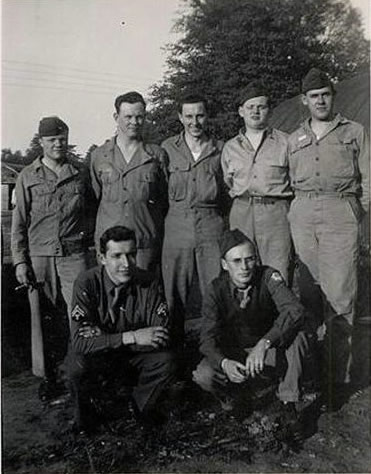
Members of 17th Major Port at Newport 1944.
Sergeant Dick Reed back row on the left. Van J Saul kneeling front row, left.
4 The ‘Friendly Invasion’
The prevailing attitudes to the American soldiers in Newport were no different to anywhere else. The GIs were surrounded by a Hollywood aura and those based in Newport were mainly from the South and were charming often with superb manners. To girls starved of romance and anything beautiful these Southern boys must have seemed to have dropped right out of scenes from “Gone with the Wind” which had appeared in the cinemas in 1939. They must have seemed irresistibly attractive. To the young women they were, to the children they were purveyors of largesse. They followed them around asking “Any Gum chum?” to which the stock answer was “Got a sister mister?” In the main the soldiers were generous and once they came to realise how few luxuries were around they scattered their gifts far and wide.
They shared their rations of Gum and Hershey bars with the children and Des Carter can remember the troops throwing Juicy Fruit sweets and chocolates from the trains travelling from the docks. They often brought gifts to the homes of their friends as a thank you for the hospitality they received from the locals. My own grandmother was given two large tins of coffee by two friendly GIs but the only people who drank it were the soldiers themselves!
They organised Christmas parties with presents for the children and their friends were often invited to shows organised for their entertainment.
Mrs. B. Abako can remember James Cagney staying at the Murrenger House when he came to Newport to entertain the troops.
The GIs were followed everywhere by the children and this wasn’t always what they wanted and many times they tried to shake them off. Mr. T. Charles told me that his ‘gang’ of youngsters used to follow the GIs and their girlfriends to their courting venues on Lawrence Hill. When they saw them the soldiers would chase them away, often falling over while running down the steep hill, much to the delight of the watching children.
The soldiers congregated in various dance halls and cinemas around Newport. Some of the factories, such as Lovell’s, would organise special dances for them but the dance floors would always be watched by MCs who would try to make sure that they didn’t indulge in any disgraceful jitterbugging which of course they did at every opportunity.
A cinema queue was the easiest place to meet a girl and there were at least seven in Newport. They drank at many of the pubs in the area and Westgate Square was commonly known as ‘Pearl Harbour’. The officers’ club was at the King’s Head Hotel. One of their main watering holes was the George Hotel in Maindee at the corner of Victoria Avenue and Chepstow Road. This could have been due to the proximity of Maindee Public Baths, which had been opened just prior to the outbreak of the war. Many of the soldiers went there both to use the baths and to swim.
5 Recreation
GIs in Newport and elsewhere in Britain were young, healthy, well paid and bored. They were far away from home and all they knew and loved, and in entertainment terms Britain was light years away from what the States could and did offer its young men.
Cwmbran was an important recreation centre. The Newport writer Haydn Davies recalls a correspondence with some elderly American soldiers who asked for information about the various areas where they were based. They were part of a transport group possibly the 487 Port Battalion [Transportation Corps] whose particular job was to organise the collection, supply, servicing and distribution of military vehicles together with their requisite fuel supplies.
Many of them left Newport and after D-Day they ended up in Antwerp, Rotterdam and Hamburg. My aunt remembers Frankie Sansaloni who was engaged to my mother for a while. He was based in Newport Docks but was sent to Germany following D Day to help restore the lines of transport in ravaged Europe.
These old soldiers remembered Malpas Castle (Court) and Cambrian (Cwmbran). They reminisced about doing the ‘Hokey Pokey' (Hokey Cokey) and were very interested in anything Haydn could tell them about their wartime home in Newport.
Haydn was able to correct them and help with their research but unfortunately for me he had destroyed all his correspondence with the GIs just 6 weeks before I had sent my letter to ‘The South Wales Argus’ asking for help.
The Drill Hall in Newport was one of their favourite dance halls although many of the local firms put on special dances for them to welcome them to Newport. Lovell’s sweet factory had many dances in their works canteen and one of my mother’s friends Mrs. Nancy Maggs remembers the MCs walking up and down the hall to make sure that none of the GIs and their partners indulged in the ‘disgraceful’ display that was called jitterbugging This was exciting if rather lewd and the British girls loved it and it caught on very quickly. Many of the iconic pictures of the GIs at play involve them doing this fast energetic dance.
Very early on it was accepted that the GIs needed somewhere where they could eat American food and associate with other Americans. A home away from home. They missed everything American, newspapers, magazines, even sports equipment was in short supply. They didn’t understand the British sense of humour, finding irony and sarcasm ‘quaint’. They wanted somewhere American on British soil. The American Red Cross took steps to remedy this by providing the ARC ‘Hotel Chain’ in every town of any size where there was an American presence.
Everything in these clubs was as “American” as possible-with one major exception - the staff. At first there were very few American admin staff in Britain and so British staff were recruited to work in these clubs. They wore American uniforms and in many ways acted as big sisters, mother hens and counsellors to the raw recruits. They gave advice, mended uniforms and introduced the rookie GIs into the vagaries of British life and customs.
In Newport the ARC Club was in the town centre. It was over “Cecil’s” Haberdashers Store (almost opposite where McDonalds is now, there is a blue door which was the old entrance to the club). Mrs Abako’s sister worked there. There was also an hostel on Stow Hill where they could stay in town if they had an overnight pass.
Mr. Charles remembers seeing the first of the American troops coming from the docks along Wharf Road in lorries decorated with blown up contraceptives which were tied to their headlamps like balloons, which delighted the children and shocked the adults! The first troops to arrive were mainly white Caucasian; the Afro-American troops were to arrive later. Lieutenant General Fry in his “Battle History of the Third Battalion" describes their journey: [7]
“On May 12th 1944 the Battalion moved out of Bewdly RR station and boarded another English train. After passing through Worcester and Cheltenham we detrained at Severn Junction, just east of Bristol. From here we moved some 12 miles by truck to a marshalling area in S.E. Wales, The camp was called Llanmartin and was a fairly permanent one with all troops being billeted in Niessen Huts (sic). At the camp we dug air raid slit trenches, held innumerable TE21s and went on some 12 mile endurance marches. These endurance marches had to be made while wearing impregnated underwear, full packs and in addition, four hand carts per company had to be pulled. The country covered during these hikes was quite hilly."
"On Sundays, the troops were permitted to visit Newport, Cardiff and Bristol. During the week only Newport was within pass range. The people in the towns were fairly friendly, but had a peculiar habit of closing all amusement centres and pubs on Sundays “
Initially the population were wary of these foreigners “Over sexed and over here “. [8] It was generally accepted that the GIs got on better with British civilians than with British troops but in Newport at least they became part of daily life and were seen everywhere on the streets, in the dance halls and in the cinemas. Most of the time they were lonely and their magnetic attraction for the local girls did nothing to alter the opinions of the men folk. However, most were met with a cheery “Hello Yank” as they strolled leisurely and relaxed about the town. They brought some sunshine into many drab lives deprived of fun by the restrictions of rationing and the blackout.
6 Settling in to life in Newport
One of the soldiers of the Railway Battalion found “The countryside with its small fields bounded by hedgerows… The tile roofed houses, the many chimneys, the well tended gardens… all food for discussion and interest”. [9]
For these small town Americans Britain and its way of life was an enigma. Class distinction didn’t exist in America (if you discount the colour prejudice) although they clearly understood the strict divide between the haves and the have nots. This was just one of the barriers to them settling in to the Welsh way of life.
Welsh place names were impossible to pronounce and they even gave up on some. Llanelli became known as ‘Slash’ and to the Americans it remained so for many years, (much as Ypres became known as ‘Wipers’ in WW1.) Then there was the difference in pronunciation, LABRATORY and LABORATORY, TOMARTO and TOMAYTO, but most of all was the problem created by the change in the meaning of so many commonplace words - FANNY is an infamous example, and many of the GIs were called RANDY! Cookies for biscuits, Candy for sweets it went on and on. They giggled hysterically like the young boys most of them were when Welsh children talked about RUBBERS (An eraser to the Brits - a condom to the GIs) but generally it was accepted that the Brits and the Americans used different forms of the same language.
They brought new customs - Trick or Treat, and Advent Calendars, but some customs they had never seen before such as Christmas Crackers which they loved.
Many of them were very religious having come from the American Bible Belt. A large number of them were Roman Catholics and in Carmarthen the Catholic churches were packed out when the GIs first arrived.
So they set about making Newport more like America, but strange anomalies occurred. While the GIs were allowed almost carte blanche entry to anywhere in Newport (except the Officers’ Club at The Kings Head Hotel) girls wishing to go to the American clubs were strictly vetted. If a girl had an American boy friend then they could apply for a special guest card. A form had to be filled in and signed and a recent photo had to be attached. I am sure that although this was adhered to strictly at first, with time and use and as the girls became known, this must have lapsed. My mother had a photograph taken (a novelty in itself) and while I still have the photograph of Ernie the GI I no longer have the one of her.
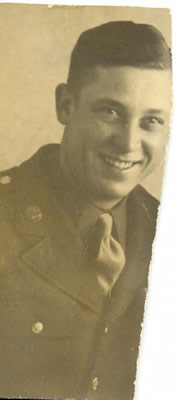
Ernie one of the GIs who was a regular visitor at my grandmotherís house.
Within a few months of the arrival of the first GI in Newport the Afro-American troops began to arrive. They were strictly segregated from the white GIs. This was historically an American rule-there was no overt colour bar in Britain, and the concept of segregation was unknown. But the troops in Newport were mainly from the Southern states, there the army way was the southern way and differences became exaggerated and enhanced.
25% of the Quartermasters and Service Corps were represented by black troops and consequently a large number were based in Newport, mainly on the tented camp at Malpas.
The Americans brought with them exciting new dances such as the jitterbug and the jive. The black GIs were wonderful at the new ‘naughty’ dances, the girls loved them but to staid adults they were at best bad and at worst shocking and degenerate, but for the young women of Newport what proved far more shocking was the attitude of the white GIs to their black compatriots. The white soldiers would not enter a dance hall if there were black GIs inside. Shift systems were devised - by the American hierarchy not the locals. Dance halls were open certain nights to the white GIs and others to the black soldiers.
My aunts remember a particular occasion when a black soldier started to dance with a white local girl, every white GI in the room walked out. My mother remembered him giving the most wonderful dance display. The result of this incident was that from that moment the girl was ostracized by the white GIs and from then on no white soldier would ask her to dance. Looking back as we do and with hindsight this seems so appalling that it is almost unbelievable but it was a sign of the times and was how people behaved.
In Newport the black soldiers were generally liked because of their good manners and friendliness. Mrs Scannel recalls a young black GI who asked her could he borrow her roller skates and then went on to give an exhibition of some superb skating, certainly the best she had ever seen. A childhood memory that she retains to this day.
In the main the black soldiers found the British far less racist than their own people back in the U.S.A
7 Wedding Belles
Any group of soldiers who weren’t engaged in fighting or training would soon become apathetic and it was no different for the GIs. They very quickly became bored and sex became a preoccupation. Very early on it became apparent that courting between young British women and the GIs would develop into long term relationships. These were frowned upon by the military hierarchy and marriage was made very difficult for the soldiers. First they had to obtain permission from senior officers before it could be even considered. Soldiers were often posted elsewhere as soon as the subject was mooted.
The relationships quickly developed between homesick soldiers and lovesick girls who had been starved of glamour and excitement for so long.
Sometimes there were marriages and they often turned out well but the couples were kept apart by circumstances and the authorities for a long time, even after the war had ended.
Jackson M. Ambaugh married Doris Norley in March 1945 in Newport. After a brief honeymoon he was sent to Austria and then home. But it was not until 1946 that Doris was able to set up home in Virginia U.S.A. [10]
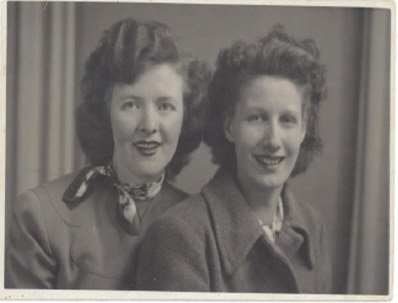
The author's mother, Eileen, and best friend Lily Watkins.
My Mother’s best friend Lily Watkins was a lovely looking girl; everyone said she looked like Lana Turner. She worked with my Mother In Lovell’s Sweet Factory. She met and got engaged to David Jacobs from Ohio. But again the war and the authorities kept them apart and it wasn’t until 1946 that they eventually married in America.
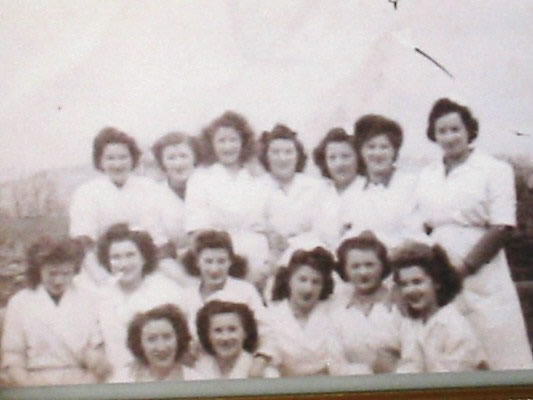
A group of Lovell’s girls including Eileen and Lily back row 3rd and 2nd from left.
Many of the Newport girls married GIs and some even managed it during the wartime.
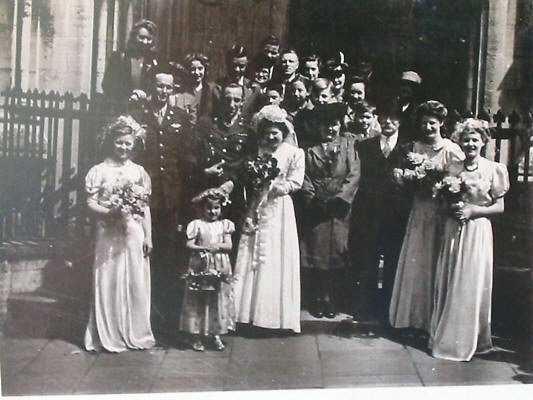
16 year old Eileen Leighfield married GI William Volger from Pitsburgh in late 1944/45 at St Mary's RC Church Stow Hill Newport
Lily and my mother were both bridesmaids at this GI wedding in St Mary’s R.C. Church Stow Hill Newport. My mother Eileen is the bridesmaid on the right as you look at the picture by the old gent in black and Lily is on the far left of the picture next to the GI. Sadly I have recently learned that the bridegroom was killed in an explosion in the steel works in Pitsburgh in 1963 and the little flower girl Maureen Lee died of meningitis within a year or so of this photo being taken.
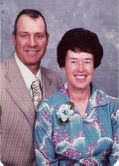
GI Leroy Fisher and his bride, Iris, from Newport.
Iris D. Cleaves was born in Newport in 1922. For most of her young life she lived at 42 Vivian Road and attended the Seventh Day Adventist church opposite Eveswell School on the corner of Rosslyn Road. Iris and Leroy Fisher were married in 1944. He was not originally based in Newport but was sent there for 3 months to sort out arrangements for Wounded soldiers. Leroy’s full title was Pfc LeRoy H. Fisher ASN 38165529 The Eighth Corps US Army. She travelled to the States with her 6 month old son Lewis on the SS Washington. This was a troop ship used to transport GI Brides. All arrangements were made by the Red Cross and Brides has to be signed for when they arrived just like parcels. It was arranged that Iris would travel to New Mexico by train and that she should get off the train at Santa Fe. This must have been an enormous undertaking for a small town Welsh girl. Someone on the train told her that there was no station at Santa Fe but that she would have to get off at Lamy which was much nearer to her destination.
She eventually reached the ranch and at first things were very different. Her cousin Joss Kelly describes it as something out of ‘Seven Brides for Seven Brothers’! She was literally expected to cook whole cows to feed hoards of hungry cowhands when her only previous experience of cooking meat was the meagre rations which were allowed at that time back home.
Luckily her marriage was a happy one but she knew of girls who had gone out and fared less well.
8 Behaviour and Attitudes
There were and are many stories told about the troops many of them apocryphal and many embroidered by time and failing memories but they persist to this day. One such tale is of the Native American Soldiers, Soldiers who were tall and with olive complexions, who looked like men with Mediterranean ancestry but who spoke in a different way. My mother was convinced that these few men were Native Americans. But as these troops were also strictly segregated from the white troops the story is difficult to believe and almost impossible to substantiate. However I have, over time, been told these stories by so many different people that I feel they must have an element of truth.
Many of the troops were perfect gentlemen, especially those from the South, but this did not apply to them all. Many were not always or even usually well-behaved. This was a recipe for trouble in an already potentially inflammable situation. They were young, fit, trained, bored, and lonely and had plenty of money. In March 1943 an American civilian retorted “If many of them got up to half the antics at home that they do in England they would spend most of their time in gaol” . [11]
Islwyn Bale wrote “The arrival of American Troops both white and black [in Newport] greatly added to the work of the police”. [12] Troop welfare was an essential part of modern warfare so the philosophy was “make em happy” and they certainly did their best. Sometimes Newport dignitaries and girls (rarely the men) were bussed into the camps to be part of the audience at these various shows. In fact most of the encounters with the GIs were social and for the most part most were a success. But the soldiers quickly learnt and understood what the word ‘no’ meant, in any language.
The friction between the British and American troops continued to a greater or lesser extent until well after D-Day. My father used to complain that the Yanks were so glamorous and well-heeled that the Tommies didn’t stand a chance with the local girls. Even those who had steady girl friends or who were engaged would find their girls dancing or spending time with the GIs when they returned on leave.
Another problem for the Brits was that for the GIs there was no rationing. Every American base was a ‘little America’ where anything could be obtained. After a while the GIs began to realise how different this was to the privations of the man in the street, and most of them were tactful enough to refuse to eat at the homes of friends, which of course used their rations, as they knew how difficult it was to obtain the staples of life, never mind the luxuries. My aunts remember their home being full of men in British and American uniforms and rarely did the Yanks turn up empty handed.
My mother developed a liking for American cigarettes and even enjoyed dried egg, and she missed them when the war ended. She always said that the British dried egg wasn’t the same.
As rationing took hold and food stuffs began to disappear from the shops any and all of the extras provided by the Americans were welcome, From our perspective of a life of plenty where food is in abundance, we can’t imagine what these losses meant, but certain foods became unobtainable. In 1948 when my cousin was given one of the first bananas to arrive in Britain, he tried to eat it with the skin on - he had only seen one before in books and then it was never peeled!
For the main part the GIs were made welcome in Newport and the surrounding areas and there was much that they liked about the town. They were regularly seen about the area in trucks and jeeps and one particular Monmouthshire teenager who worked at a brewery in Aberbeeg remembers them turning up regularly at the brewery in their jeeps. [13] But these weren’t their only modes of transport. They loved our bicycles considering them of much better quality than their own. They bought them new when they could and second-hand when they couldn’t. They were godsends to the troops stationed in out-of-town bases such as Llanmartin and St. Brides.
Visits to local families were prized and the American Red Cross often arranged the initial meetings. But from the prevailing anecdotal evidence they did quite well on their own!
9 D-Day
We know now that preparations for D-Day had been in train for many months and the troops knew or at least guessed that something major was about to happen. The Newport based soldiers were involved very early on as they were service troops concerned with the administration of troop movements. Many were intrinsic parts of the transport groups such as the drivers and mechanics. Newport was vital in the build up to D-Day because of the docks and the railways and the transport links. From 14th of November 1943 Newport became the base of the District HQ Western Base HQ. this stretched from the River Severn right up the middle of the country and included the whole of Wales and Scotland in its area of influence. [14]
D-Day and the build up of troops in Newport was the focus of so many of the contributions and personal memories that I received. But none was more poignant than my own mother’s memories. She had been dating a GI called Frank and he was one of those unfortunate soldiers who was there one day and gone the next, with no apparent prior warning. She had just accepted the fact that he might never return again when he did for one week and then he was sent to Hamburg and presumably was sent directly home from Germany to the U.S.A. She had already refused his offer of marriage but was never to see or hear from him again and never discovered whether or not he survived the war.
Many of these memories of the GIs last days in Newport are the same. Hundreds of trucks, tanks and troop transports lined Forge Lane, waiting to embark from Newport Docks. The docks themselves were so full that it was said that you could walk across the docks on the decks of ships. David Hall relates “Everyone in Newport knew something was going on from all the frantic activity of the last week or so... June 5th Invasion Eve”.
Previous to this day “Seven huge cranes on barges had been assembled (To put together the Mulberry Harbours) plus tugboats, oil, and other support barges plus six block ships (ships only in ballast that were to be sailed over then sunk as part of the Mulberry Harbour). In the immediate days before, almost 40,000 tons of ammunition was brought by rail into the docks and loaded onto the 16 coasting vessels and 18 Liberty ships”. [15]
American troops were transported by rail directly onto the ships and hundreds of tanks and lorries previously stored in Forge Lane were loaded and sent to France.
Des Carter’s memories confirm this. He wrote in his personal memoir “A Schoolboy’s view of Newport 1930-1945” “Eventually before D-Day there were huge amounts [of American soldiers] everywhere. Tredegar House and all the lanes around were crammed with tanks, guns, jeeps and lorries and on Forge Lane you could nearly walk from one end to the other on the top of all the tanks, guns and lorries in four lanes”.
Mr. Carter lived on the top of the Gaer estate overlooking the railway and the docks. He continues “On June 6th 1944… I looked out of my window at Newport docks which had been crammed with ships of every description… and the docks were completely empty. They had all gone to the beaches on Normandy”.
By Sunday June 11th everything had gone.
So for a while most of the Yanks left Newport. Mr. Charles remembers that when the Rangers left Llanmartin to go up country for D-Day the camp was eventually turned over for German POWs.
By V.E. day most of the GIs were gone often and mostly without warning - many like Frank went to Germany - the lucky ones went home.
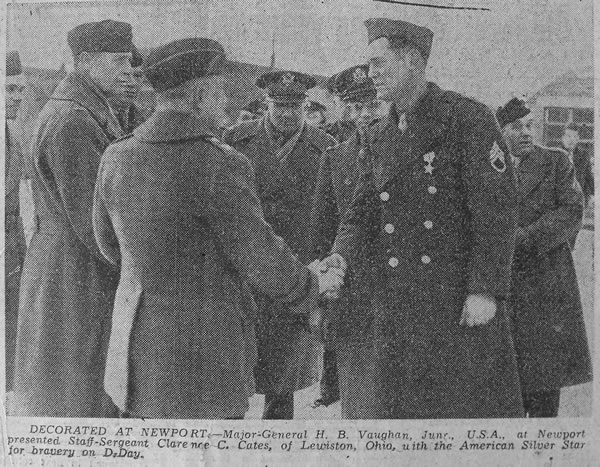
South Wales Argus: "DECORATED AT NEWPORT – Major-General H. B. Vaughan, Junr., U.S.A. at Newport presented Staff-Segeant Clarence C. Cates, of Lewiston, Ohio, with the American Silver Star for bravery on D-Day."
10 We’re going Home!
Going home was, however, not yet an option for many of the troops. Thousands were still engaged in war with Japan and consequently when Japan was defeated the celebrations were riotous especially among the American soldiers who remained in Newport. “American soldiers arrived in their fire-engine and circled the town, and anyone who could get on had a ride with them”. [16]
On 9th December 9th 1945 the 487 Port Battalion boarded the SS Argentina in Le Havre France, its next stop was home! The last of the Americans left in June 1946 in 22 railway carriages from Newport Station to their ports of embarkation.
The ‘Friendly Invasion’ was over!
Footnote
In 1945 the troop in Newport were the Officers and Men of the 51st Port TC and Attached Units.
The Commanding Officer was Colonel George B. Norris. The Chaplain was Major Frank Lambert and the Organist was T/5 Frank Pukit.
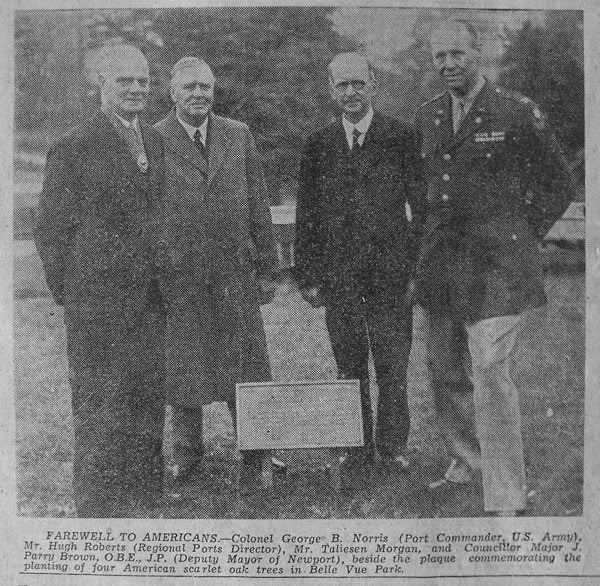
South Wales Argus, 1945. "FAREWELL TO AMERICANS – Colonel George B. Norris (Port Commander, U.S. Army), Mr. Hugh Roberts (Regional Ports Director), Mr. Taliesen Morgan, and Councillor Major J. Parry Brown, O.B.E., J.P. (Deputy Mayor of Newport), beside the plaque commemorating the planting of four American scarlet oak trees in Belle Vue Park."
11 Memories
Mr. T Charles
“There was a camp at St. Brides. Four army men drove into a reen in a jeep and were drowned, this camp was for enlisted men.”
Mrs B. Abako
“On VE night as everybody was making their way into the town centre the American Army Trucks were picking up the people to take them into town.”
Mr. David Hall
“In 1943 Newport had only 12 air raid warnings due to rocket launcher batteries being deployed each side of the Bristol Channel to protect the many ports, some of these batteries I am told were manned by US soldiers.”
Mrs J. Scannell
“There was a camp at the top of Lodge Hill (Caerleon) - close to the iron age fort at Lodge Farm. The camp housed ack-ack guns and was first used by British troops. However, when the Americans arrived, they laid down a concrete road on Lodge Hill (previously only a track to the farm) to accommodate their equipment.
“My Husband-to-be, who attended Newport High School encountered a lonely GI who kindly bought him a milk shake in the latest milk bar in Commercial Street. He, apparently, was stationed at the Barracks (Barrack Hill).”
Mr J. Dyer
“My Mam, now dead, worked in the bomb factory and told me on weekends the US troops used to frequent Westgate Square. The famous Westgate Hotel was hence commonly called Pearl Harbour.”
Mr Haydn Davis
“My email contacts {a group of veteran GIs} told me that many of the 1943 Newport Yanks left at the same time to finish up in European ports like Antwerp, Rotterdam and Hamburg doing the same jobs as they had done in Newport, except it was now unloading vital supplies instead of loading.”
Mr. Des Carter
“They even had anti-aircraft guns on Newport Bridge which I passed every day coming to Newport Tech in 1944. It was the only main bridge they could use for South Wales and the railway bridge at that time………. I could see from my house a field full of rockets where Duffryn School is now, protecting the docks.”
Joan Higgins
"I began my education at Clytha School in Bryngwyn Road in 1942, at the age of five, and can well remember the American soldiers sitting in their jeeps parked at the roadside. I believe they were billetted at the old St.John's School on the corner of Bryngwyn Road and Risca Road, near to the Handpost shops.
We children found them to be very generous with their sweet rations, willingly obliging when asked 'Got any gum, Chum'? And on one well-remembered occasion when they 'invaded' our school-grounds and, from the top of a high bank threw down to us such an assortment of sweets, gum and oranges, the like of which we had never seen. Our fairly normal playtime turned into uproar until the noise brought the Head, Miss Bunning out of her room, and our Yankee friends disappeared as silently as they had come!
My brother and I used to go to Sunday School at Llanthewy Road Baptist Church at that time, and the word soon went around that one of the American Servicemen would be coming to speak to us the following Sunday. There was a good attendance, all hoping that he might bring us some chewing gum, and he did!"
12 Cuttings From The South Wales Argus
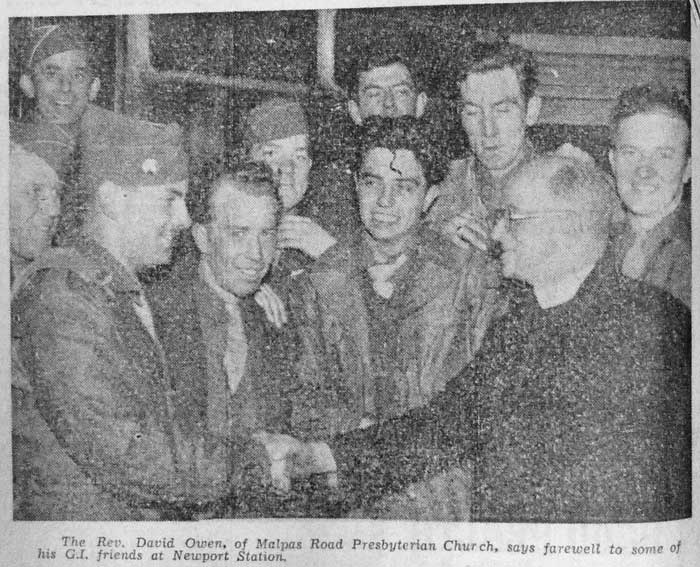
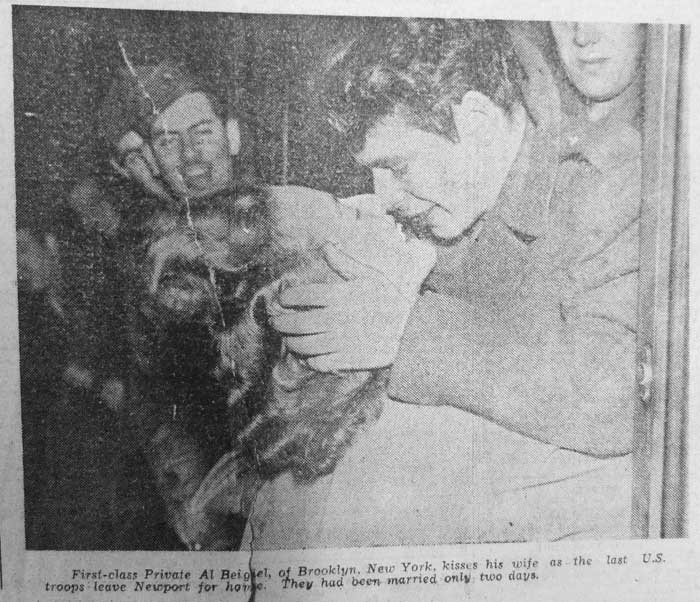
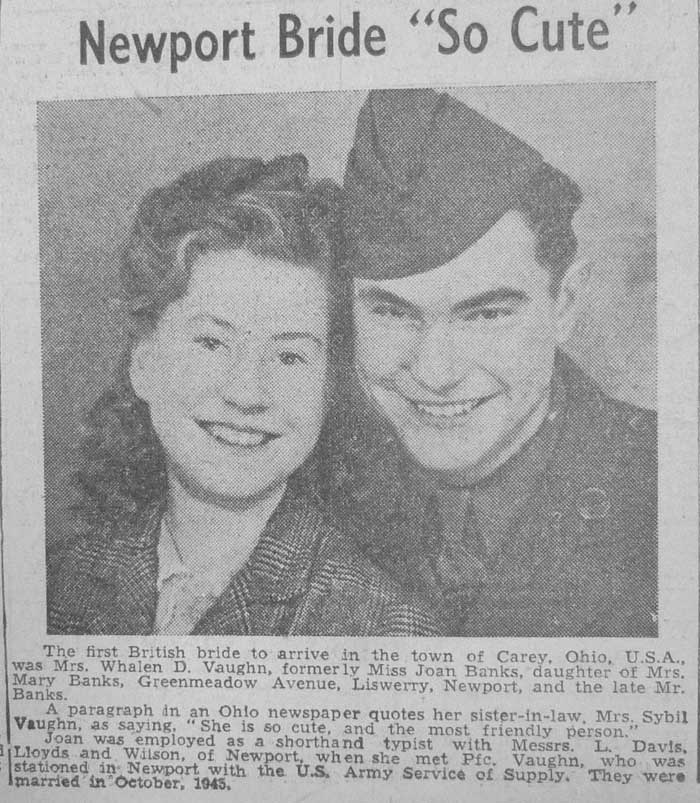
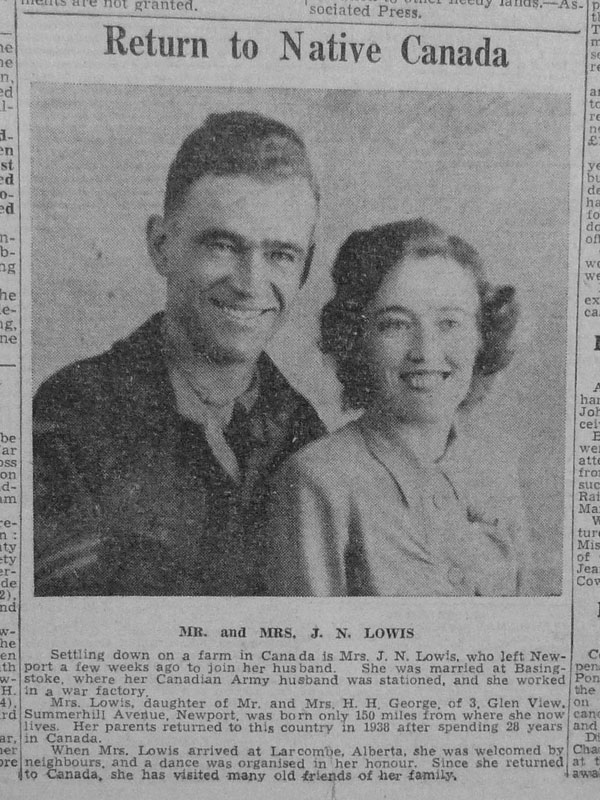
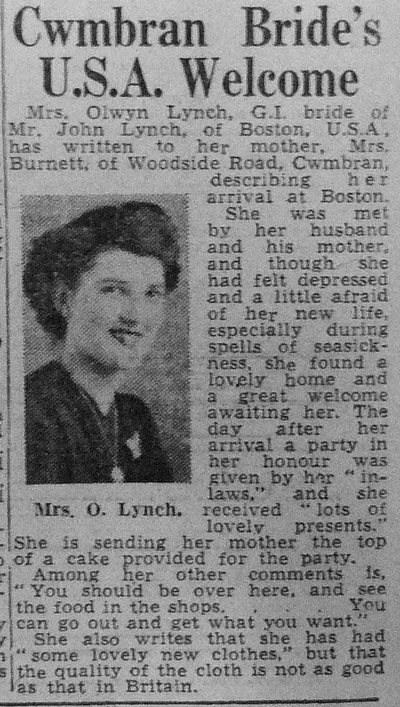
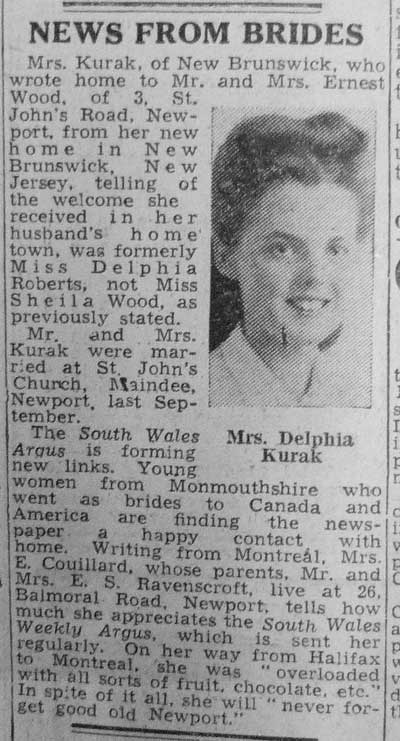
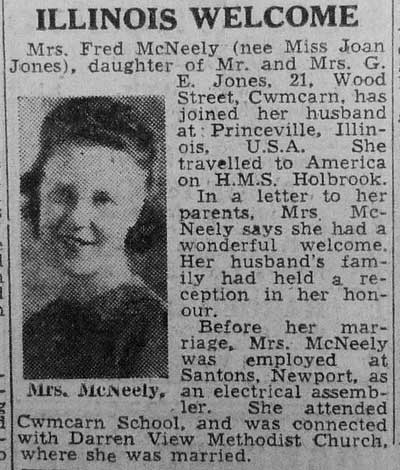
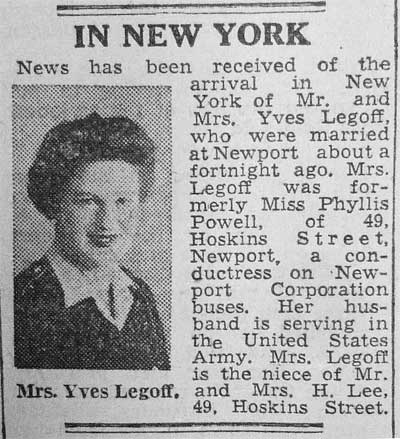
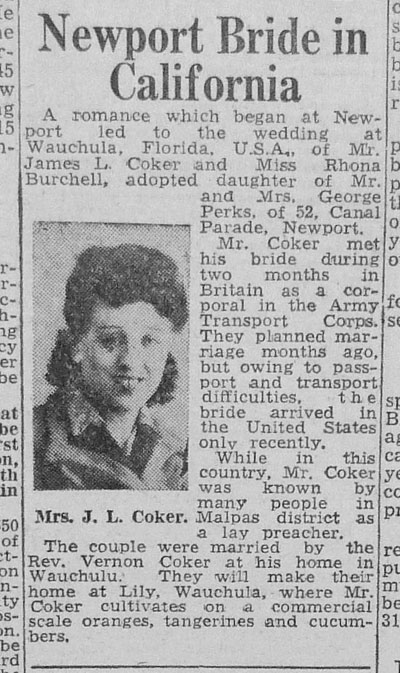
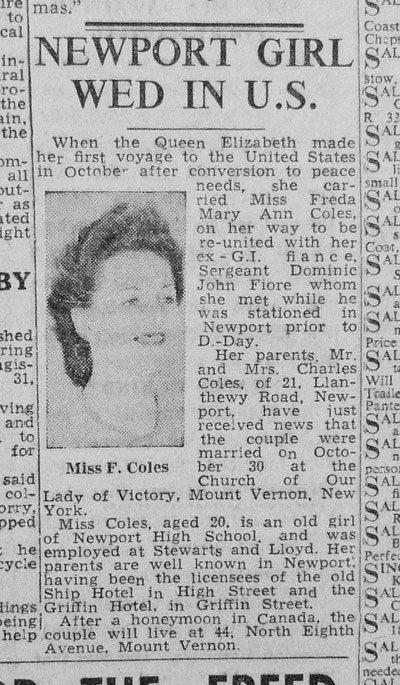
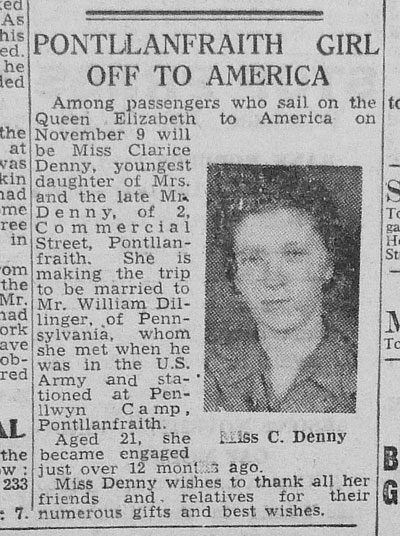


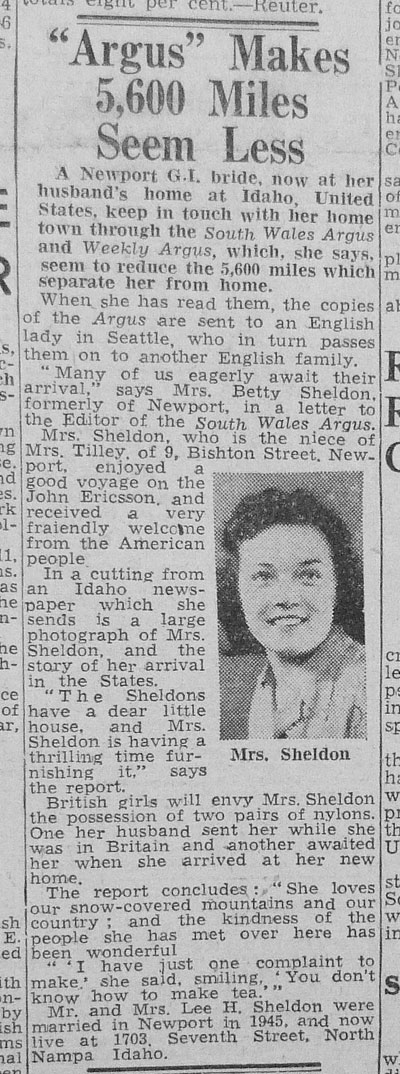

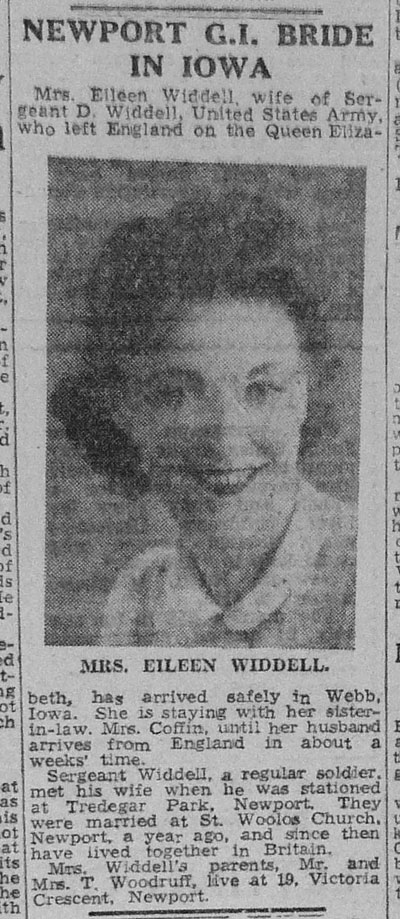
Bibliography
BALE, Islwyn “Through Seven Reigns; A History of Newport Police Force 1836-1959”. Griffin Press Pontypool.
BUCKINHAM, Mike, “Reflecting on century of Memories”. Article in “South Wales Argus” July 29th 2009.
FRY, Lieutenant General “Battles History Of The 3rd Battalion 358th Regiment 90th Infantry Division”. pages 5 and 6.
KNIGHT, Cliff and JONES, Alan, “Fifty Years of Newport 1900-1949; Some Incidents in the History of Newport”. Oakwood Press 2008 ISBN 978 0853616825.
JONES, Glyndwr, G., “Notes on the United States (U.S.A.) Army Stationed at Caerphilly, Glamorgan During the 1939-45 War”. Ref Misc. MSS 1921 Gwent Record Office.
LONGMATE, Norman, ”The GIs; The Americans in Britain 1942-1945”. Hutchinson 1975 ISBN 0091241200.
MORSE, Bryan, “A Moment in History”. Y Lolfa Cyf 2007 Talybont Ceredigion SY24 5AP 978 1847710192.
MOUNTFORD E.R., ”The USA 756th RSB (Railway Shop Battalion) at Newport (Ebbw Junction)” . Locomotion papers 170. Oakwood Press 1989 085361380.
REYNOLDS, David “Rich Relations; The American Occupation of Britain 1942-45”. Harper Collins 1995 0002551276.
References
[1] When to eat when to wash, when to sleep-everything was prescribed. Like his clothing and provisions a man was simply Government issue”. “Rich Relations, Chp6 P76, Note 11.
[3] As part of my research it was suggested by Mr. David Hall a Newport Historian that I should look at E.R.Mountford’s “The USA 756th RSB (Railway Shop Battalion) at Newport (Ebbw Junction)-Locomotion Papers 170 Oakwood Press 1989 085361X. I purchased a copy of the booklet and found it not only invaluable but also of considerable interest, especially to my husband and ex Ebbw Engine Driver who can remember the drivers talking about the Railway battalion at Ebbw.
Haydn Davies refers to a GI named Harry Davis who states in his autobiography that his regiment arrived at Llanmartin on the 16th July 1944 and stayed until 31st August 1944 and 3 days later were landed at Utah Beach in Normandy.
[4] Haydn Davies refers to a GI named Harry Davies who states in his autobiography that his regiment arrived at Llanmartin on the 6th July 1944 and stayed until the 31st August 1944. Three days later they were landed on Utah Beach Normandy.
[5] Information obtained from Stephen M. Kohler Washington DC on the Parish Chest Website forum in response to a question from Ladkiss “How can I find an American Soldier?” 6/12/2007 http://www.british-genealogy.com/forums/archive/index.php/t-24082.html
[6] “South Wales Argus” article by Mike Buckinham “Reflecting on a Century of Memories”. Mrs Florence Price, Wednesday July 29th 2009.[7] Lieutenant General Fry , “Battle History of the Third Battalion 358th regiment 90th Infantry Division” pages 5 and 6 (Commanding Officer).
[8] “Rich Relations” Introduction page XXVIII.
[9] Jones, Glyndwr, G. “Notes on the United States Army stationed at Caerphilly, Glamorgan during the 1939-45 War”, Ref Misc 1921 Gwent Record Office.
[10] “Rich Relations”, Introduction page XXVI.
[11] “R.R.” p249 in reference to Stephen E. Ambrose “Band of Brothers” (New York 1992) p.47. [Webster] AARC report on US troops, 8th March 1943. Copy in NA RG 332 ETO AG CGC 250.1 SOS.
[12] Bale, Islwyn “Through Seven Reigns: A History of Newport police Force 1836-1959. Griffin press Pontypool.
[13] Longmate, Norman “The GIs; the Americans in Britain 1942-45” Hutchinson 1975 0091241200 page 192.
[14] Longmate, Norman Page 41.
[15] Hall, David unpublished book “The History of the Fire Service in Newport” Supplied to me by Mr. Hall by email.
